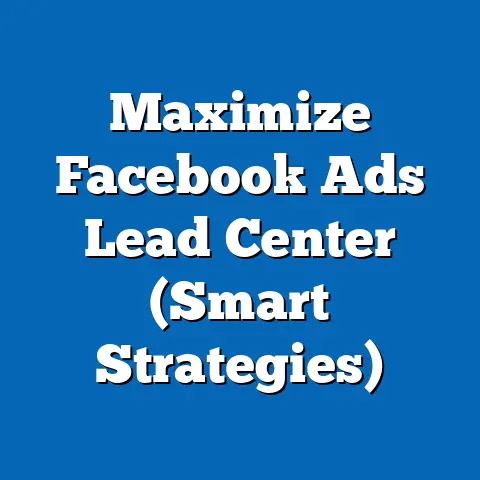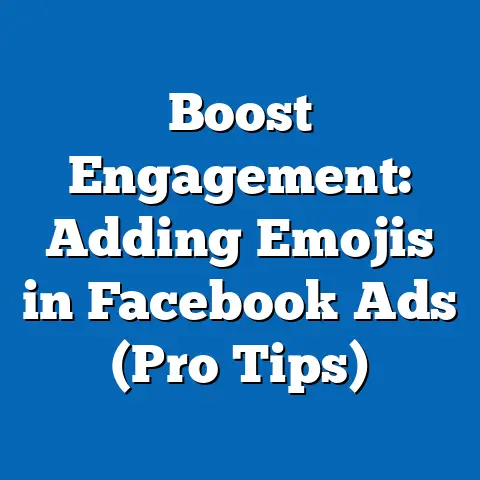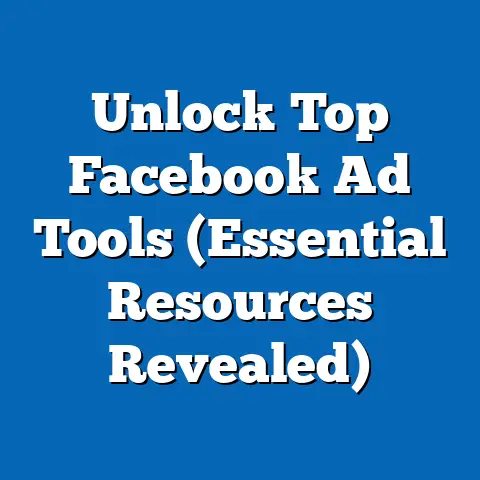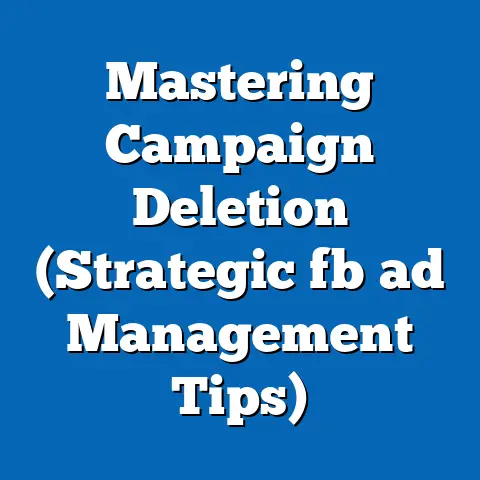Boost Facebook Ads Success Today (Expert Strategies)
In the ever-evolving world of digital marketing, Facebook advertising remains a powerhouse for businesses of all sizes. But simply running ads isn’t enough; you need to be strategic, adaptable, and, most importantly, aware of the shifting landscape. One of the most effective ways to boost your Facebook ad performance is by tapping into seasonal trends.
Think about it: consumer behavior changes dramatically throughout the year. During the holidays, people are actively searching for gifts and deals. In the summer, travel and outdoor activities are top of mind. By aligning your ad campaigns with these seasonal shifts, you can create more relevant, engaging, and ultimately, more successful ads.
I’ve seen firsthand the incredible impact of seasonal campaigns. Back when I was managing ads for a local bakery, we saw a massive surge in sales during the holiday season simply by tailoring our ads to showcase festive treats and special offers. It wasn’t just about changing the images; we tweaked the ad copy to evoke holiday nostalgia and targeted users who had previously engaged with our holiday-themed posts. The results were staggering – a 300% increase in online orders compared to the previous month!
Section 1: Understanding Seasonal Trends
What are Seasonal Trends and Why Do They Matter?
Seasonal trends are predictable patterns in consumer behavior that occur at specific times of the year. These trends are often influenced by holidays, weather changes, cultural events, or even economic cycles. Understanding and capitalizing on these trends is crucial for Facebook advertisers because it allows you to:
- Increase Relevance: Ads that align with seasonal themes feel more relevant to users, capturing their attention and increasing engagement.
- Boost Conversions: By catering to specific needs and desires during particular times of the year, you can drive higher conversion rates.
- Improve ROI: Seasonal campaigns often yield a better return on investment (ROI) due to increased user interest and engagement.
Think about the back-to-school season. Parents are actively searching for deals on school supplies, clothing, and electronics. A retailer targeting parents with ads featuring these products during this time is far more likely to see success than if they ran the same ads in July.
Examples of Seasonal Trends Across Industries
The beauty of seasonal trends is that they apply to virtually every industry. Here are a few examples:
- Retail: Holidays (Christmas, Thanksgiving, Black Friday, Cyber Monday), Back-to-School, Valentine’s Day, Mother’s Day, Father’s Day
- Travel: Summer vacations, Spring Break, Holiday travel, Off-season travel
- Food & Beverage: Thanksgiving feasts, Summer barbecues, Pumpkin spice season, New Year’s Eve celebrations
- Health & Fitness: New Year’s resolutions, Summer body goals, Back-to-school fitness routines
- Home & Garden: Spring cleaning, Summer gardening, Fall decorating, Holiday home prep
Remember that bakery I mentioned earlier? We didn’t just focus on Christmas. We ran ads for heart-shaped cookies for Valentine’s Day, patriotic cupcakes for the Fourth of July, and spooky-themed treats for Halloween. Each campaign was tailored to the specific season, resulting in a steady stream of customers throughout the year.
How Consumer Behavior Changes with the Seasons
Understanding why consumer behavior changes with the seasons is just as important as knowing what those changes are. Here’s a glimpse:
- Holidays: People are in a gift-giving mindset, actively searching for presents for loved ones. They’re also more receptive to deals and promotions.
- Weather Changes: Warmer weather often leads to increased outdoor activities and travel. Colder weather encourages cozy indoor experiences and comfort food.
- Cultural Events: Events like the Super Bowl, the Olympics, or local festivals can drive specific purchasing behaviors.
- Economic Cycles: Tax season, back-to-school spending, and end-of-year sales influence consumer spending habits.
By understanding these motivations, you can craft ad campaigns that resonate with your target audience on a deeper level.
Case Studies and Statistics on Seasonal Campaigns
The proof is in the pudding, as they say. Let’s look at some real-world examples and statistics that demonstrate the power of seasonal campaigns:
- Retail: According to the National Retail Federation, holiday sales account for approximately 20% of annual retail sales. This highlights the massive opportunity for retailers during the holiday season.
- Travel: Expedia reports that summer is the most popular time to travel, with bookings peaking in June and July. Travel companies that target users with summer vacation deals during this time are likely to see a significant increase in bookings.
- Food & Beverage: A study by Nielsen found that pumpkin spice products generate over $500 million in sales each year. This illustrates the incredible demand for seasonal flavors and products.
These examples demonstrate that seasonal campaigns can drive significant revenue and growth for businesses across various industries.
I once worked with a clothing boutique that struggled to maintain consistent sales throughout the year. We implemented a seasonal campaign strategy, focusing on different clothing styles for each season. For example, we ran ads featuring lightweight dresses and sandals in the summer, cozy sweaters and boots in the fall, and festive holiday outfits in the winter. The results were phenomenal – a 40% increase in overall sales and a significant reduction in seasonal dips.
Identifying Upcoming Seasonal Trends for Your Niche
So, how do you identify the right seasonal trends for your business? Here are some practical steps:
- Analyze Your Past Sales Data: Look for patterns in your sales data to identify peak seasons and trends.
- Track Industry News and Trends: Stay informed about upcoming events, holidays, and cultural happenings in your industry.
- Monitor Social Media: Pay attention to what your target audience is talking about on social media to identify emerging trends.
- Use Google Trends: Explore Google Trends to identify trending search terms related to your products or services.
- Competitor Analysis: See what your competitors are doing for seasonal campaigns. What’s working for them, and what’s not?
Takeaway: Understanding and leveraging seasonal trends is essential for maximizing the impact of your Facebook ad campaigns. By aligning your ads with the changing needs and desires of your target audience, you can increase relevance, boost conversions, and improve ROI.
Next Steps: Start researching upcoming seasonal trends relevant to your industry and brainstorm ideas for how you can incorporate them into your Facebook ad campaigns.
Section 2: Crafting Compelling Ad Copy
The Elements of Effective Ad Copy
Compelling ad copy is the heart and soul of any successful Facebook ad campaign. It’s what grabs users’ attention, communicates your value proposition, and motivates them to take action. Here are the key elements of effective ad copy:
The Importance of Seasonal Language and Themes
During seasonal campaigns, it’s crucial to incorporate seasonal language and themes into your ad copy. This helps to create a sense of relevance and urgency, making your ads more appealing to users.
For example, during the holiday season, you might use words like “festive,” “joyful,” “gifting,” or “celebration.” In the summer, you might use words like “sunshine,” “vacation,” “outdoor,” or “refreshing.”
By using seasonal language, you can tap into the emotions and desires associated with specific times of the year.
Creating Urgency and Relevance During Peak Seasons
Peak seasons are characterized by increased competition and heightened user expectations. To stand out from the crowd, you need to create a sense of urgency and relevance in your ad messaging.
Here are some tips:
- Highlight Limited-Time Offers: Use phrases like “Limited Time Only,” “Sale Ends Soon,” or “While Supplies Last.”
- Emphasize Exclusivity: Use phrases like “Exclusive Offer,” “Members Only,” or “VIP Access.”
- Focus on Seasonal Benefits: Highlight how your product or service can help users enjoy the season to the fullest.
I remember running a Black Friday campaign for an e-commerce store that sold electronics. We used the phrase “Biggest Sale of the Year” in our ad copy, and it generated a massive surge in traffic and sales. The key was to create a sense of urgency and let users know that they couldn’t afford to miss out on the opportunity.
Examples of Successful Seasonal Ad Copy
Let’s look at some examples of successful ad copy from various brands that utilized seasonal trends effectively:
- Holiday Season: “Spread the Holiday Cheer with [Your Brand]’s Festive Gifts! Shop Now and Save Up to 50%.”
- Summer: “Soak Up the Sunshine with [Your Brand]’s Refreshing Summer Collection! Get Ready for Vacation with Stylish Swimwear and Accessories.”
- Back-to-School: “Get Ready for Back-to-School with [Your Brand]’s Essential Supplies! Shop Now and Save on Backpacks, Notebooks, and More.”
These examples demonstrate how to incorporate seasonal language, create urgency, and highlight the benefits of your product or service.
A Framework for Writing Persuasive Ad Copy
Here’s a simple framework for writing persuasive ad copy tailored to seasonal campaigns:
- Identify Your Target Audience: Who are you trying to reach with your ad?
- Highlight the Seasonal Trend: What seasonal trend are you capitalizing on?
- Communicate Your Value Proposition: What are the benefits of your product or service?
- Create Urgency and Relevance: Why should users click on your ad now?
- Include a Clear Call to Action: What do you want users to do?
By following this framework, you can craft ad copy that is both persuasive and relevant, driving higher engagement and conversions.
Takeaway: Compelling ad copy is essential for capturing users’ attention and driving action during seasonal campaigns. By incorporating seasonal language, creating urgency, and highlighting the benefits of your product or service, you can craft ad copy that resonates with your target audience and delivers exceptional results.
Next Steps: Review your existing ad copy and identify opportunities to incorporate seasonal language and themes. Experiment with different headlines, body text, and CTAs to see what performs best.
Section 3: Visuals and Creative Elements
The Significance of Visuals in Facebook Ads
In the fast-paced world of social media, visuals are king. People scroll quickly through their feeds, and a compelling image or video is often the only thing that can stop them in their tracks. Visuals are particularly important during seasonal campaigns because they can evoke emotions and create a sense of nostalgia.
Think about the classic holiday ads featuring snow-covered landscapes, cozy fireplaces, and heartwarming family gatherings. These visuals instantly transport users to a specific time and place, making them more receptive to the ad’s message.
Selecting Images, Videos, and Graphics That Resonate
Choosing the right visuals for your Facebook ads is crucial for capturing users’ attention and conveying your message effectively. Here are some tips:
- Use High-Quality Images: Avoid blurry or pixelated images.
- Choose Relevant Visuals: Select images, videos, and graphics that are relevant to your product or service and the seasonal theme.
- Evoke Emotions: Use visuals that evoke the emotions associated with the season, such as joy, excitement, or nostalgia.
- Showcase Your Product or Service: Highlight your product or service in a visually appealing way.
- Consider Using Videos: Videos are more engaging than static images and can be a great way to tell a story or showcase your product in action.
I once ran a campaign for a flower shop during Valentine’s Day. We used a stunning image of a bouquet of red roses, and it generated a massive response. The key was to choose a visual that was both beautiful and relevant to the occasion.
Maintaining Brand Consistency While Incorporating Seasonal Elements
While it’s important to incorporate seasonal elements into your visuals, you also need to maintain brand consistency. Your ads should still reflect your brand’s identity and values.
Here are some tips:
- Use Your Brand Colors: Incorporate your brand colors into your visuals.
- Use Your Brand Font: Use your brand font in your ad copy and graphics.
- Maintain a Consistent Tone: Ensure that your visuals and ad copy have a consistent tone.
- Use Your Brand Logo: Include your brand logo in your visuals.
The goal is to create ads that are both visually appealing and recognizable as belonging to your brand.
A/B Testing Different Creative Assets
A/B testing is a powerful tool for optimizing your Facebook ad campaigns. By testing different creative assets, you can determine which visuals perform best and use that information to improve your ads.
Here are some things you can A/B test:
- Images vs. Videos: See which format performs better.
- Different Images: Test different images to see which ones resonate most with your target audience.
- Different Headlines: Test different headlines to see which ones grab users’ attention.
- Different CTAs: Test different CTAs to see which ones drive the most conversions.
The key is to test one element at a time so you can accurately measure the impact of each change.
Examples of Visually Appealing Seasonal Ads
Let’s look at some examples of visually appealing ads that successfully integrated seasonal themes:
- Coca-Cola’s Holiday Ads: Coca-Cola’s holiday ads are famous for their heartwarming visuals and nostalgic themes.
- Starbucks’ Pumpkin Spice Latte Ads: Starbucks’ pumpkin spice latte ads feature cozy images of steaming mugs and autumnal colors.
- REI’s #OptOutside Campaign: REI’s #OptOutside campaign encourages people to spend time outdoors during the holiday season.
These examples demonstrate how to create visually appealing ads that resonate with your target audience and reinforce your brand’s message.
Takeaway: Visuals are a critical component of successful Facebook ad campaigns, especially during seasonal promotions. By selecting high-quality, relevant visuals that evoke emotions and maintain brand consistency, you can capture users’ attention and drive higher engagement.
Next Steps: Review your existing ad visuals and identify opportunities to incorporate seasonal elements. Experiment with different images, videos, and graphics to see what performs best.
Section 4: Targeting the Right Audience
The Importance of Audience Targeting in Facebook Ads
You could have the most compelling ad copy and eye-catching visuals in the world, but if you’re showing your ads to the wrong people, you’re wasting your time and money. Audience targeting is the process of selecting the specific group of people who are most likely to be interested in your product or service.
Facebook offers a wide range of targeting options, allowing you to reach users based on their demographics, interests, behaviors, and more. By targeting the right audience, you can increase the relevance of your ads, improve your click-through rates, and boost your conversions.
Using Demographic, Geographic, and Psychographic Targeting
Facebook’s targeting options can be broadly categorized into three main types:
- Demographic Targeting: This allows you to target users based on their age, gender, education level, relationship status, job title, and more.
- Geographic Targeting: This allows you to target users based on their location, such as country, state, city, or zip code.
- Psychographic Targeting: This allows you to target users based on their interests, behaviors, and opinions.
During seasonal campaigns, it’s important to consider how these different targeting options can be used to reach seasonal shoppers.
For example, if you’re selling holiday gifts, you might target users who are married, have children, and are interested in gift-giving. If you’re selling summer vacation packages, you might target users who are interested in travel, outdoor activities, and beaches.
Leveraging Facebook’s Targeting Tools
Facebook offers a variety of powerful targeting tools that can help you reach your ideal audience. Here are some of the most useful:
- Custom Audiences: This allows you to target users who have previously interacted with your business, such as website visitors, email subscribers, or customers.
- Lookalike Audiences: This allows you to create audiences that are similar to your existing customers or website visitors.
- Interest-Based Targeting: This allows you to target users based on their interests, hobbies, and passions.
- Behavior-Based Targeting: This allows you to target users based on their online behaviors, such as purchasing habits or social media activity.
I’ve found that custom audiences and lookalike audiences are particularly effective during seasonal campaigns. By targeting users who have previously shown interest in your brand, you can increase the relevance of your ads and drive higher conversions.
Creating Custom Audiences and Lookalike Audiences
Creating custom audiences and lookalike audiences is a relatively straightforward process. Here’s a quick overview:
- Custom Audiences: You can create custom audiences by uploading a list of email addresses or phone numbers, or by using Facebook’s pixel to track website visitors.
- Lookalike Audiences: You can create lookalike audiences by selecting a source audience (such as your custom audience or website visitors) and specifying the desired size and similarity level.
Once you’ve created your custom audiences and lookalike audiences, you can use them to target your Facebook ads.
Success Stories of Effective Audience Targeting
Let’s look at some examples of brands that effectively targeted their audience during seasonal campaigns:
- A Clothing Retailer: Targeted users who had previously purchased winter clothing with ads featuring new arrivals and holiday promotions.
- A Travel Agency: Targeted users who had previously booked summer vacations with ads featuring early bird deals for next year’s summer travel.
- A Restaurant: Targeted users who lived near their restaurant with ads featuring holiday-themed menus and special offers.
These examples demonstrate how effective audience targeting can be in driving results during seasonal campaigns.
Takeaway: Audience targeting is a critical component of successful Facebook ad campaigns. By using demographic, geographic, and psychographic targeting, as well as Facebook’s powerful targeting tools, you can reach the right audience at the right time and drive higher engagement and conversions.
Next Steps: Review your existing audience targeting strategies and identify opportunities to refine your targeting during seasonal campaigns. Experiment with custom audiences and lookalike audiences to see what performs best.
Section 5: Analyzing and Optimizing Ad Performance
Tracking Key Performance Indicators (KPIs)
Running a Facebook ad campaign without tracking your results is like driving a car with your eyes closed. You need to know where you’re going and how you’re getting there. Tracking key performance indicators (KPIs) allows you to measure the success of your campaigns and identify areas for improvement.
Some of the most important KPIs to track during seasonal campaigns include:
- Reach: The number of unique users who saw your ad.
- Impressions: The number of times your ad was displayed.
- Click-Through Rate (CTR): The percentage of users who clicked on your ad.
- Conversion Rate: The percentage of users who completed a desired action, such as making a purchase or signing up for a newsletter.
- Return on Ad Spend (ROAS): The amount of revenue generated for every dollar spent on advertising.
By tracking these KPIs, you can get a clear picture of how your ads are performing and identify areas where you can optimize.
Tools and Metrics for Measuring Ad Success
Facebook offers a variety of tools and metrics for measuring ad success. Here are some of the most useful:
- Facebook Ads Manager: This is the primary tool for managing and tracking your Facebook ad campaigns.
- Facebook Pixel: This is a snippet of code that you can install on your website to track conversions and build custom audiences.
- Google Analytics: This is a powerful web analytics tool that can provide insights into user behavior on your website.
By using these tools, you can get a comprehensive understanding of your ad performance and identify areas for improvement.
Strategies for Real-Time Optimization
The beauty of Facebook advertising is that you can make changes to your campaigns in real-time based on performance data. This allows you to optimize your ads on the fly and maximize your ROI.
Here are some strategies for real-time optimization:
- Adjust Your Bids: If your ads are not getting enough impressions, you can increase your bids. If your ads are generating too many impressions and not enough conversions, you can lower your bids.
- Refine Your Targeting: If your ads are not reaching the right audience, you can refine your targeting criteria.
- Pause Underperforming Ads: If some of your ads are not performing well, you can pause them and focus on the ads that are driving results.
- Test New Creative: If your ads are becoming stale, you can test new creative to see if you can improve performance.
I once had a campaign that was performing poorly during the first few days. After analyzing the data, I realized that the ads were not reaching the right audience. I refined my targeting criteria, and the campaign’s performance immediately improved.
Post-Campaign Analysis for Future Strategies
Once your seasonal campaign is over, it’s important to conduct a post-campaign analysis to identify what worked well and what didn’t. This will help you to improve your strategies for future seasonal campaigns.
Here are some questions to ask during your post-campaign analysis:
- What were the key takeaways from the campaign?
- What worked well?
- What could have been done better?
- What are the key insights that can be applied to future campaigns?
By conducting a thorough post-campaign analysis, you can learn from your successes and failures and improve your performance in the future.
Case Studies of Data-Driven Optimizations
Let’s look at some examples of brands that improved ad performance through data-driven optimizations:
- An E-Commerce Store: Used A/B testing to identify the most effective ad copy and visuals, resulting in a 20% increase in conversion rate.
- A Local Restaurant: Used geographic targeting to reach users who lived near their restaurant, resulting in a 15% increase in foot traffic.
- A Travel Agency: Used custom audiences to target users who had previously booked vacations, resulting in a 25% increase in repeat bookings.
These examples demonstrate how data-driven optimizations can lead to significant improvements in ad performance.
Takeaway: Analyzing and optimizing your ad performance is essential for maximizing your ROI during seasonal campaigns. By tracking key performance indicators, using Facebook’s tools and metrics, and implementing real-time optimizations, you can improve your ad performance and drive higher conversions.
Next Steps: Review your existing ad campaigns and identify opportunities to track KPIs, use Facebook’s tools and metrics, and implement real-time optimizations. Conduct a post-campaign analysis after your next seasonal campaign to identify what worked well and what didn’t.
Conclusion
Tapping into seasonal trends is a powerful strategy for boosting your Facebook ad success. By aligning your ads with the changing needs and desires of your target audience, you can increase relevance, boost conversions, and improve ROI.
Throughout this article, we’ve explored the key strategies for leveraging seasonal trends, including:
- Understanding seasonal trends and their impact on consumer behavior
- Crafting compelling ad copy that incorporates seasonal language and themes
- Selecting visuals that resonate with the emotions tied to specific seasons
- Targeting the right audience using demographic, geographic, and psychographic targeting
- Analyzing and optimizing ad performance based on data-driven insights
I urge you to implement these strategies in your upcoming campaigns and monitor your results. Experiment with different approaches, track your KPIs, and continuously optimize your ads to achieve the best possible performance.
Remember that Facebook advertising is an ongoing process of learning and refinement. By staying informed about the latest trends and best practices, you can continue to improve your ad performance and achieve your business goals.
Now, I’d love to hear from you! What are your experiences with seasonal Facebook ads? What strategies have worked well for you? Share your insights in the comments below. And if you found this article helpful, be sure to follow for more expert tips and strategies on Facebook advertising.






